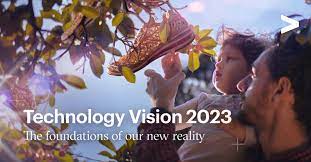We’re three-quarters of the way into 2023, but I just came across Accenture’s Technology Vision 2023 report. It’s pretty high level, definitely on the vision side, and geared towards Accenture’s enterprise clients, but I thought it might be interesting to give it a look.
In Accenture’s view, we’ve got a “step change” coming, in which our physical and digital lives will “seamlessly converge.” They see several technology trends that are pushing us towards this convergence. In this post, I’ll focus on their first two trends.
First up: Digital identity – “ID for everyone and everything” where there will be a more centralized approach to identity than having to have a separate ID for every app and platform. An example they give is Apple Wallet, which has gone beyond being a payment system to “let users store and share government-issued IDs like driver’s license. Wallet, of course, is already used as a central repository for digital items like boarding passes and tickets to shows and sporting events.
One major area where Accenture sees digital ID and the convergence of the physical and digital realms is healthcare. Currently, health-related data exists across a range of disparate platforms and hosts, “forcing patients to repeatedly validate who they are.” Having a trusted digital identity will remove a lot of friction from the system. Emerging technologies that will play a big role here include biometrics and tokenization. New technologies will help remedy the security problem inherent in the current approach to digital identity, where “The entire ecosystem has become overly reliant on leveraging functional data, like email addresses or social logins, to access services or identify people across the web,” methods that are susceptible to hacking.
Big – really big – data is the next area Accenture tackles. Here’s a forecast to consider: In 2020, 47 zettabytes of data were created. It’s predicted that, by 2035, each year will see the creation of 2,142 zettabytes of data. Talk about overwhelming! Organizations will need a robust data architecture to handle all the data they have access to, not to mention a better ability to ensure that the data is accurate and secure. Then, of course, there’s the challenge of actually gleaning insights and acting on them.
Remember that Accenture is focused on the convergence of the physical and digital worlds. Here’s where data comes in. Sure, much of the data that makes up big data is based on our direct interactions with the Internet – that and someone entering information on us. But sensing technology is making an increasing contribution to the array of data available, capturing data about the physical world at an accelerating clip. Some of this is coming from personal devices, like a smart watch that monitors, say, our heart rate. Other comes from industrial systems and the environment, where “as the cost of sensors drops and their capabilities grow, we are entering a time with extremely precise and expansive information about our bodies, environments, and world.”
All this accelerated data gathering would not, of course, be possible without communications technology. Today, “we are seeing the ability to transmit data grow dramatically—over long distances, to places previously unconnected, and in nearly real-time.” Today, we’re talking about 5G (and satellite) communications technology. 6G is in the works, with commercial availability currently expected by 2030. Transmission rates just keep on getting faster and faster, bringing us bigger and bigger data to grapple with.
As I said at the outset, the Accenture report is pretty high level, but interesting nonetheless. In my next post, I’ll bring you the other trends they discuss.
